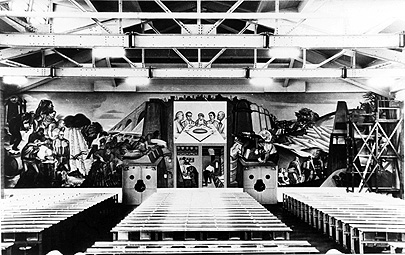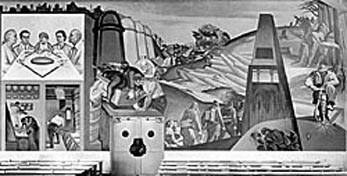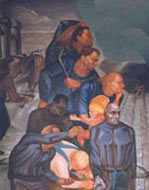Having previously visited this New York Correction History Society site, retired Deputy Warden James Larkin decided in September 2005 to send NYCHS a package of material for archival and possible web purposes.

Above is an uncropped but reduced-in-size version of the 5x8-inch photo of the Rikers Penitentiary mess hall mural. The image version on the opening page of this NYCHS presentation had been enlarged to 5.3x9.7 inches after being cropped across its top, eliminating a few cafeteria ceiling beams.
|
|
Included among the items sent by Jim Larkin was a 5x8-inch black and white photograph that his cover note said he believed had been taken in the Rikers Island Penitentiary a few decades before he first served there.
While a captain assigned to the Penitentiary in the 1970s, he was given the photo by veteran Rikers Correction Officer Charles J. Gulotta who was nearing retirement.
Larkin himself never saw that mural at the Penitentiary aka then officially the House of Detention for Men. The Deputy Warden -- "the last to be promoted to that rank by examination" -- concluded his 20-year career with DOC in 1984 while serving as commanding officer of the Rikers Island Hospital.
NYCHS web research came across, on the New Deal Network site, another B&W image of the mess hall with its mural but minus the artist's scaffold that is shown on the 5x8-inch photo's far right.

Above: From the New Deal Network site, an NARA (SPB) image of the mural's right panel. Note that the worker drilling can be seen on the far right. In the Larkin-donated photo, the muralist's scaffold obscures that view.
|
|
The New Deal Network (NDN) is a research and teaching resource on the World Wide Web devoted to the public works and arts projects of the New Deal.It was launched in October, 1996, by the Franklin and Eleanor Roosevelt Institute (FERI), in collaboration with the Franklin D. Roosevelt Presidential Library, Marist College, and IBM.
NDN is now based at the Institute for Learning Technologies (ILT) at Columbia University.
The NDN site identifies the image as showing the right panel of a mural entitled Man's Daily Bread by Harold Lehman at Rikers Island Penitentiary and provides a link to the Harold Lehman web site, an exquisitely beautiful cyberspace labor of love by his daughter, Lisa Lehman Trager.

The above detail from Harold Lehman's Rikers Penitentiary mess hall mural Man's Daily Bread forms part of the logo of Lisa Lehman Trager's web site dedicated to her father's life and work.

|
|
On her site, she tells the story of her father's experience becoming a major American artist. The Harold Lehman saga, spanning seven decades, includes his association with Jackson Pollock and D.A. Siqueiros and participation as a mural painter in the Federal Art Projects (FAP), part of the Works Progress Administration (WPA).
During the Depression, President Franklin D. Roosevelt launched the WPA as an agency to initiate and oversee a wide variety of emergency employment and relief programs. Employing artists to paint murals on public buildings was just one among its many far ranging activities but one that receives much Internet attention, in part because the subject matter is so visually compelling as well as historically interesting.
Lisa Lehman Trager devotes approximately 20 web pages on her site to her father's 20x70-foot Rikers mural, including color images of the overall mural and close-ups of several sections.
In cooperation with the NYC administration under Mayor LaGuardia and DOC under Commissioner Austin H. MacCormick, the WPA had invited Lehman to paint a mural on the Penitentiary cafeteria wall. Harold Lehman agreed to do so and decided that a food-related subject would be appropriate.

The (above) image of Harold Lehman's self portrait as a young man and a photo image of him much older (below) appear on his daughter Lisa Lehman Trager's web site dedicated to his life and work.

|
|
The artist also decided that depiction of earning one's bread by the sweat of one's brow would be quite relevant in a correctional setting without being overtly preachy.In keeping with that theme, he entitled it Man's Daily Bread and painted scenes within it showing the plowing, planting, harvesting, and baking involved with making bread; its place on the family dinner table, and some of the industries in which people work to earn their bread.
The mural's quality was widely recognized in the art world of the era. Several details from it were shown in such venues as the National Society of Mural Painters, the Whitney Museum, and the American Art Today exhibit at the 1939-40 World's Fair. They have been acquired by major collections such as the Smithsonian National Museum of American Art in Washington, D.C., and the Wolfsonian Foundation in Miami Beach.
Unfortunately, appreciation of the mural as an irreplaceable American artistic and historical treasure did not extend to the command personnel managing the correctional institution on whose mess hall wall it was displayed.
Sometime circa 1962 a warden or one of his deputies decided to have the mural removed for reasons and a fate unknown.
Apparently the original wall surface was tile not suitable for a mural. Wooden panels had been anchored to it in order receive the canvas upon which the mural was created. To remove the mural, the canvas-covered wooden panels may have been taken down as intact units. Could they have been stored somewhere and forgotten? An intriguing question. As of this posting (October 2005), there is no known record of its removal or its disposition after removal.
There also appears no known record of any inquiry having been made among New York's many art experts about the value of the huge wall painting prior to it being discarded; no known record of it needing repair; and no known record of advance notice having been given about any pending plan to rip it from its place of honor for more than two decades.
One day in 1975, Harold Lehman returned to Rikers. He wanted to know how his mural had fared after approximately four decades. He was interested in seeing its state of preservation and whether it needed any restoration. Only then did he learn that it had been pulled down about a dozen years or so earlier.
Sad to say, the vanishing of Harold Lehman's Man's Daily Bread would prove not to be the last disappearance of a valuable work of art from Rikers Island, though its circumstances seem to have been quite unlike those of a much later and more notorious loss.